They say… 
Best beer and travel writing award 2015, 2011 -- British Guild of Beer Writers Awards
Accredited Beer Sommelier
Writer of "Probably the best book about beer in London" - Londonist
"A necessity if you're a beer geek travelling to London town" - Beer Advocate
"A joy to read" - Roger Protz
"Very authoritative" - Tim Webb.
"One of the top beer writers in the UK" - Mark Dredge.
"A beer guru" - Popbitch.

|
London’s Best Beer, Pubs and Bars Updates
Central London – Soho and Leicester Square
Traditional pub
28 Rupert Street W1D 6DJ
T (020) 7437 1415
Open 1100 (1200 Sat-Sun)-2330 (2400 Fri-Sat, 2230 Sun). Children welcome lunchtimes only.
Cask beer 4 (Fuller’s, Hopback, Timothy Taylor, guest) Cask marque, Other beer 2 keg, 3 bottles
Food Simple, good value pub grub, Outdoors Standing room and barrels on alley
Tue quiz, Sun lunchtime and evening live jazz/blues, meetings & functions
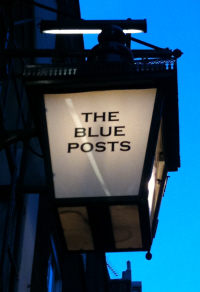 The Blue Posts, Rupert Street, London W1 The best evidence that a genuine community exists alongside the throngs of tourists, shoppers and entertainment seekers in this part of London can be found in its handful of thriving local pubs. The Blue Posts, at the end of an alleyway on the western edge of Chinatown, is a case in point. Michael, its landlord since 2004, says most of his customers are regulars he knows by name, but the casual visitor can still expect a warm and friendly welcome. The downstairs bar, which looks like it was last refitted in the 1970s, is small and basic but homely, with an impressive collection of maneki neko beckoning cat ornaments; upstairs there’s another smallish square room with a big window, where bands play on Sundays and BBC scriptwriters hold regular meetings.
The lengthy traditional menu is impressively low priced for the area, with sandwiches, jacket potatoes, curries, cottage pie, chile con carne, smoked salmon salad and a choice of hot vegetarian options. The beer range at this Enterprise tenancy opts for better known names which are kept to Cask Marque standards – London Pride, Summer Lightning and Landlord are regulars with a changing guest that might come from Black Sheep, Wells & Young’s or Wychwood. Keg Hoegaarden and Leffe and bottled Budvar, Duvel and Newcastle Brown extend possibilities. At Christmas they go for strangely sculpted topiary rather than a tree.
Visitor note. Most authorities on pub names explain names like the Blue Posts by the pre-literate practice of using visual features like blue painted poles to identify particular buildings. But that doesn’t explain why there are so many pubs in the West End with that name – currently five but once at least seven, with the nearest only a few minutes walk away in Berwick Street. Michael says blue posts marked the boundaries of the hunting park that formerly stood here, but if so it must have been a very strangely shaped park. The Blue Posts in St James’s claims blue posts once indicated sedan chairs for hire. Whatever the reason, make sure you arrange to meet in the right one!
National Rail Charing Cross Underground Leicester Square, Piccadilly Circus Cycling Links to LCN+6A, 39, 50 Walking Jubilee Walkway
London’s Best Beer, Pubs and Bars updates
Central London – Clerkenwell & Smithfield
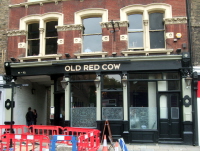 Old Red Cow, London EC1 Contemporary pub
71 Long Lane EC1A 9EJ
T (020) 7726 2595 W www.theoldredcow.com tw oldredcow
Open 1200 – 2300 (2400 Thu-Sat). Children welcome until early evening.
Cask beer 4 (Local and unusual guests), Other beer 10 keg, 32 bottles, Also wines
Food Imaginative pub grub, “English tapas”
Sat acoustic music, Sun quiz, occasional Meet the Brewer events and launches, pub for hire
The next venture from the people that brought you the Dean Swift in SE1, this “local ale house” reopened following refurbishment in April 2011 and quickly established a keen following. Well located by the southeast corner of Smithfield Market, within sight of the Barbican and in an area rapidly developing a dense population of good beer venues, it is obviously cut from the same cloth as the Dean but adapted to a different space and location. The small bar downstairs has the cask pumps and high stools around tall communal tables; upstairs is a keg-only bar and more space, with smaller tables and long padded benches.
Big mirrors, old German beer posters and quirky wallpaper create a pleasant environment in which to enjoy drink and food that also follows the Dean’s lead. The cask taps pull local ales from Redemption and Sambrook’s, with BrewDog and Dark Star also popular choices. There’s a good choice of German and Austrian kegs including Maisels Weisse, Schremser, Stiegl and Veltins, plus Camden Town and changing Belgian and US guests. Highlights of the well chosen bottled menu are Brooklyn East India Pale, Odells 90/-, Sierra Nevada Torpedo, Harviestoun Ola Dubh, Hirter Privat Pils and Trappists from Chimay, Orval, Rochefort and Westmalle. Imaginative food might include gourmet sandwiches with chips, Welsh rarebit soldiers, whitebait, mussels in cider, premium burgers and sage dumplings in tomato sauce.
National Rail Farringdon Underground Barbican Cycling LCN+7, 39, Angel Walking Link to Jubilee Walkway
London’s Best Beer, Pubs and Bars updates
North London — Canonbury & Barnsbury
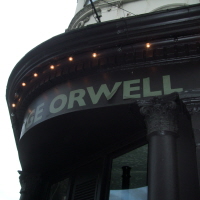 The George Orwell, London N1 Contemporary pub
382 Essex Road N1 3PF
T 07973 695517 W www.thegeorgeorwell.com f thegeorgeorwell tw georgeorwellpub
Open 1630 (1200 Sat-Sun) -2300 (2400 Thu, 0200 Fri-Sat, 2230 Sun). Children welcome until 1900.
Cask beer 2 (local), Other beer 4 keg, 10 bottles, Also 2 ciders/perries, 10 malts, specialist bourbon, rum, mezcal
Food Scotch eggs and pies only, Outdoor Small beer garden
Thu quiz, Fri, Sat live acoustic music or DJs, board games, functions
This big old Victorian pub near the top of Essex Road has been through numerous incarnations over the years – not so long ago it was a goth club. Since early 2010 it’s been a friendly, independently owned free house with a smallish but well chosen beer list, reviving a former name that commemorates 20th century writer and keen pubgoer George Orwell (real name Eric Blair, 1903-50), who lived nearby in the mid-1940s. Some of the interior decoration picks up on the theme, with Spanish civil war posters recalling Orwell’s involvement with the International Brigades in the 1930s [see comment below for historical correction on this]. Otherwise it’s floorboards, wooden tables and a cosy corner with bookshelves, sofas and a standard lamp, while a small narrow courtyard to the side serves as a beer garden. It’s regularly used for parties and functions but is always kept open to the public too.
Cask comes from local producers like Redemption or Sambrook’s, and at least five different bottled Kernel beers are stocked, alongside Freedom lagers, Sierra Nevada Pale and Innis & Gunn. Freedom also features on the keg taps alongside Staropramen and Pilsner Urquell. In fact it fails rather miserably against Orwell’s checklist for the perfect pub as outlined in his essay ‘The Moon Under Water’, with a distinct lack of aspirins and foaming stout in pewter pots, but there are numerous other compensations.
National Rail Essex Road Overground Canonbury Underground Angel Bus Ockendon Road (numerous Angel) Cycling LCN+ Angel, Camden, Dalston, Hackney Walking Link to New River Path
London’s Best Beer, Pubs and Bars updates
East London — Other locations: Ilford
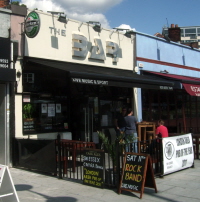 The Bar, Gants HIll, Ilford IG2 Bar
19 Seven Ways Parade, Woodford Avenue, Ilford IG2 6JX
T (020) 8551 7441 W thebargantshill.co.uk
Open 1200-2330 (2400 Fri-Sun)
Cask beer 2-3 (local), Other beer 1-2 keg
Outdoor Front terrace on street
Fri, Sun live music, Sat karaoke, pool, big screen sport, occasional beer festivals and meet the brewer evenings
Observant readers of the guide may well spot the vast swathe of suburban east London between Leytonstone and Upminster where I’ve been unable to recommend a single notable beer outlet. This little place, simply titled The Bar, goes some way to plugging the gap with its dedication to offering a modest but well-kept range of local microbrewed cask. It’s in an unpromising location deep in 1930s suburbia, in one of a parade of shops typical of its period right by the busy, and recently refurbished, Gants Hill roundabout on the A12, with the tube station beneath in a labyrinth of subways. A sports bar interior with a plethora of big screens entertaining what when I called on a Saturday afternoon was an all-male clientele didn’t bode especially well either. But it didn’t win the local CAMRA branch’s Pub of the Year award in 2011 for its industrial keg lager, as owner Darren Bullman is clearly passionate about his beer.
The cask ales – always two, expanded to three at weekends – are sourced locally, with beers from nearby Ha’penny often available, and Brentwood and Mighty Oak often spotted too. They’re in top nick, well promoted through posters and tasting notes, and sold at a discount to card carrying CAMRA members. The craft choice is slightly widened by the likes of Fuller’s Honey Dew on keg. And there’s just enough pavement width to make the outdoor seating worthwhile. Quite a find especially considering the area, though note there’s no food other snacks.
Visitor’s note. The imposing art deco barrel vaulted spaces of Gants Hill Tube station influenced the Moscow Metro, as London Underground architects advised their Soviet counterparts in the 1930s.
Underground Gants Hill Cycling LCN+ 55, Redbridge Greenway Walking Link to Redbridge Greenway
London’s Best Beer, Pubs and Bars updates
East London — Docklands
 Henry Addington, London E14 Traditional pub
22 Mackenzie Walk E14 4PH
T (020) 7719 1114 W www.nicholsonspubs.co.uk/thehenryaddingtoncanarywharflondon
Open 1000 (1200 Sun)-2330 (1830 Sat-Sun). Children welcome until 1800.
Cask beer 7 (Fullers, Sharp’s, St Austell, Nicholson’s guests) Cask Marque, Other beer 3 keg, 7 bottles, Also 1 cider, wines
Food Nicholson’s breakfasts and pub grub, Outdoor Front terrace on dockside
Sun live jazz
A traditionally styled Nicholson’s pub in an extraordinary location, this inhabits the ground floor of one of the early 1990s office blocks that flanks the pyramid-topped landmark Canary Wharf tower (1 Canada Square), opening out onto the walkway around what remains of the 1802 West India Middle (Export) Dock. Outside are tables on the water’s edge; the long and spacious wood panelled interior with its mix of tables, high stools and sofas feels a little fake but is comfortable enough, with friendly staff.
The chain’s regular trio of London Pride, Doom Bar and Tribute are joined at the handpumps by guests from the seasonal list, so might reach to BrewDog, Camden Town, Cropton, Hopdaemon, Moor, Rudgate or St Peter’s for example: there was a good choice of strongish cask IPAs when I called. A wider than usual choice for the chain of keg and bottled beers encompasses Duvel, Franziskaner wheat beer, Meantime Chocolate and Sierra Nevada Pale Ale. Food is standard Nicholson’s fare, majoring on steaks. A welcome outlet for good beer in the heart of modern Docklands, this is understandably popular with office workers during the week, and more relaxed though still well used on weekend daytimes, when Canary Wharf is still surprisingly lively.
Insider tip. The pub is named after Tory politician Henry Addington (1757-1844), a doctor’s son who was the UK’s first middle class prime minister between 1801-04 – the period when the docks were built. Follow the dockside a short distance east for a spectacular view of the Canary Wharf tower.
Underground, DLR Canary Wharf Cycling NCN1, link to CS3 Walking Link to Thames Path, Lea Valley Walk
London’s Best Beer, Pubs and Bars updates
Central London — Southbank
Traditional pub
25 Roupell Street SE1 8TB
T (020) 7207 0784
Open 1100 (1200 Sat-Sun)-2300 (2230 Sun). Children in restaurant only.
Cask beer 8 (Adnams, Caledonian, Dark Star, Ringwood, Sambrook’s, Wychwood, occasionally changing guests), Also 1 cider
Food Good value Thai
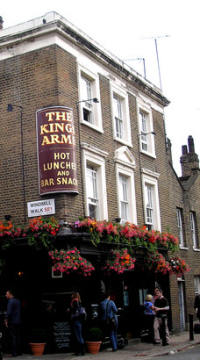 Kings Arms, London SE1. (c) Dr Neil Clifton and licensed for reuse under a Creative Commons license. The Roupell Street Conservation Area is one of central London’s true hidden gems. Tucked between the National Theatre and Waterloo East are several lengthy and almost entirely unspoilt terraces of workers’ cottages developed between the 1820s and 1840s by John Palmer Roupell, sympathetically framed by lamp standards in Victorian style. If it looks a bit like a set from a prestige BBC period drama, that’s probably because you’ve seen it featured in several such productions.
Halfway along Roupell Street itself and pleasingly breaking up a long row of identical façades is this corner pub, built as part of the original development to serve the estate. It retains its smallish, partitioned public and saloon bars, lettered in an incongruous 1960s font that recalls a past life as an Ind Coope house. Space extends to a backyard converted into a conservatory, decorated with curiosities including plates, vintage boxing posters and little quotes praising the virtues of wine. This operates independently as the keenly priced Yvonne’s Thai Cuisine, though stools and shelves to the side accommodate drinking overspill from the bars.
This charming pub’s beer offer has fluctuated over the years but has recently improved with a wide and infrequently changing choice of cask beer including several from the various subsidiaries of Marston’s. When I last looked it included classic Midlands mild Banks’s Original, a rare sight in London, plus Brakspear Oxford Gold, Jennings Cumberland Ale, Ringwood Boondoggle, alongside Adnams Bitter, Caledonian Deuchar’s IPA and Dark Star Partridge, with Sambrook’s Wandle providing a local touch. While it’s often busy with well-informed commuters and visitors to nearby attractions like the Southbank and the Old and New Vic theatres, it stands sufficiently apart from all of these to retain a community feel.
National Rail, Underground Waterloo Cycling NCN4, LCN+ 6, 6A, 7 Walking Thames Path, Jubilee Greenway, Jubilee Walkway
London’s Best Beer, Pubs and Bars updates
Central London – Covent Garden
Traditional pub, regional heritage pub
91 Strand WC2R 0DW
T (020) 7379 9883 W www.nicholsonspubs.co.uk/thecoalholestrandlondon
Open 1000-2300 (2400 Fri-Sat). Children welcome until 1900, later if eating in wine bar
Cask beer 8-10 (Fuller’s, Sharps, St Austell, Nicholson’s guests) Cask Marque, Other beer 3 keg, 4-5 bottles, Also wines
Food Nicholson’s breakfasts and pub grub
Occasional meet the brewer events
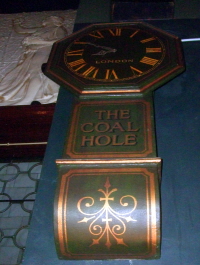 Coal Hole, London WC2 Originally a palace owned by the Counts of Savoy (Savoie in France) stood on the site of today’s Savoy complex on the Strand. In 1881 Richard D’Oyly Carte built a theatre here to showcase the comic operas of W S Gilbert and Arthur Sullivan, adjoined eight years later by London’s first true luxury hotel. The short entrance drive holds the distinction of being the only road in London where traffic keeps right. The collection of buildings includes this intriguing pub and wine cellar, though the folk histories associated with it are rather inaccurate. It was never the coal cellar for the hotel, nor was it the place where carousing actor Edmund Kean (1789-1833), who often performed at the nearby Lyceum, founded his drinking club The Wolves. Kean’s club was based at an earlier, and rather disreputable, pub and music hall called the Coal Hole, slightly to the east in Fountain Court, demolished in 1880. This likely got its name from an 18th century landlord known as the Singing Collier. The present pub was purpose built in 1904 and originally known as the Strand Wine Lodge – you can still just see this name over the doors and it’s echoed in the monogram ‘SWL’ which is designed into the leaded windows. A vinous theme dominates much of the sumptuous interior, a riotous fusion of mock-Tudor, neo-classical and art nouveau designed by architect T E Collcutt. Bunches of grapes feature in the elaborate terracotta fireplace and are carried by young ladies in bas relief on friezes high up on the walls. But the old pub name eventually came back to haunt the new place.
Currently it’s one of the Central London Nicholson’s pubs that takes particular advantage of the chain’s seasonal guest list. Besides standard London Pride, Doom Bar and Tribute you might find beers from Batemans, Brain’s or Thornbridge. There are keg taps for Suffolk Blonde lager (brewed by Shepherd Neame), Franziskaner and Pilsner Urquell, and a few bottles from Budvar, Duvel and Sierra Nevada. Food is the regular Nicholson’s pub grub menu.
Insider tip. Even though there’s a more limited beer range, do look at the wine cellar downstairs, an attractive wood panelled space with a door out onto the alleyway at the back of the Savoy complex. The steep drop reminds us that before the Victoria Embankment was built, this was the actual riverbank.
National Rail Charing Cross Underground Charing Cross, Covent Garden Cycling LCN+6, links to NCN4 Walking Thames Path, link to Jubilee Walkway
London’s Best Beer, Pubs and Bars updates
Central London – City
 Magpie, London EC2 Traditional pub
12 New Street EC2M 4TP
T (020) 7929 3889 W www.nicholsonspubs.co.uk/themagpiebishopsgatelondon
Open 1000-2330 Mon-Fri, closed Sat-Sun.
Cask beer 10 (Fuller’s, Sharp’s, St Austell, Nicholson’s guests) Cask Marque, Other beer 1 keg (Staropramen), 2 bottles
Food Nicholson’s pies and pub grub menu
Functions
The day after I finally drew the line under the ever-expanding list of potential entries for the guide, Mitchells and Butlers emailed me with a long list of additional pubs for consideration, drawing particular attention to those that made a special effort with their beer range. The latter category included this pub and having visited it I realised I’d done my readers a disservice by missing it, particularly given its useful location.
Regulars on cask are London Pride, Doom Bar and Tribute but manager Paul McCallion ensures the rest of his extensive row of handpumps makes best use of Nicholson’s seasonal guest beer range and is unafraid of stocking stronger, darker and more unusual options. Cropton (including one of their US-inspired beers), Leeds, Rudgate (a welcome mild), St Peters, Titanic and White Horse were among the offerings when I called. Budvar and Meantime Chocolate are in bottle.
Food is the usual hearty Nicholson’s fare – fish and chips, pies, steaks, salads, salmon en croûte – and can be enjoyed in the bar or the small but elegant dining room upstairs. Unsurprisingly given its location it’s very much a city boy pub – I seemed to be the only customer not in a suit – but it’s otherwise a welcoming place in an attractive pedestrianised alleyway right opposite Liverpool Street station.
National Rail, Underground Liverpool Street Cycling CS1, LCN+ 0, 39, links to Islington
London ’s Best Beer, Pubs and Bars updates
Central London – Bloomsbury, Euston & St Pancras
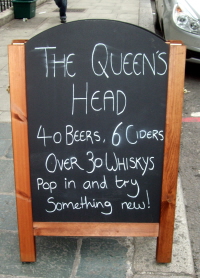 The Queens Head London WC1 Contemporary pub
66 Acton Street WC1X 9NB
T (020) 7713 5772 W www.queensheadlondon.com f The-Queens-Head tw TheQueens_Head
Open 1200 (1500 Sat, 1600 Sun) – 2300. Children welcome until 1900.
Cask beer 3 (Oakham, unusual guests), Other beer 7 keg, 40 bottles, Also 4 ciders/perries
Food Cheese, ham, pork pies, with beer matching, Outdoor Small rear courtyard
Tue comedy, Wed folk, Thu swing jazz, quiz planned, pub for hire
Another beer-focused modern makeover of a forgotten and decaying local, this place reopened in June 2010 but seems to have slipped under the radar of many of the capital’s beer hunters, perhaps because while pursuing quality and a warm welcome it’s gone for a more accessible and less geeky approach than some. Tucked down a side street off Grays Inn Road a short walk from Kings Cross, this handsome pub benefits from some fine original features happily preserved thanks to decades of underinvestment, including extensive ceramic tiling, engraved glass, mirrors and light fittings from the gaslight era, with several strikingly unusual standards on the bar. An open main bar with simple furniture and plenty of standing room is extended by a lovely green painted snug at the back.
Oakham JHB is near-permanent on cask, alongside beers from the likes of Dark Star, Harviestoun, Redemption and Windsor & Eton. Imported lagers come from Kaiserdom, König and Licher, with craft keg from BrewDog, Camden Town and Harviestoun. Suppliers of bottles include BrewDog, Coopers, Kernel, Meantime, Odell, Samuel Smith, St Austell and Timothy Taylor – note there’s considerably more in the fridges than appears on the printed list. Food is limited to cold plates of cheese and charcuterie, some of which are helpfully provided with matching beer suggestions. A friendly place that deserves wider recognition, under the same ownership as Simon the Tanner in SE1.
National Rail, Underground Kings Cross St Pancras Cycling LCN+0 Walking Links to Jubilee Greenway, Jubilee Walkway
First published in Beers of the World, February 2009
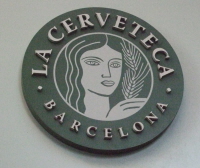 La Cerveteca, Barcelona Catalunya may be some way south of Europe’s “beer belt” and its Penedès vineyards may have a well-earned place in world wine guides, but this corner of the northern Mediterranean is also the heartland of Spain’s industrial revolution. In the mid-19th century, railways and textile factories changed the face of the ancient port of Barcelona, the region’s capital, and breweries soon followed to slake the thirsts of its legions of new workers.
The only survivor of this period is Damm, established in 1876 by an expat from Strasbourg. Now a 5million hectolitre business, its key Estrella brand, the self-proclaimed “beer of Barcelnoa”, is an unexciting industrial lager. Truer to its Rhineland heritage are dark Damm Bock and strong Märzen-style Voll Damm, but beyond these and a few bars and restaurants offering better-known Belgian and German imports, what else does this otherwise beautiful, cosmopolitan and much-visited city have to offer the beer lover?
 Exterior of La Cerveteca, Barcelona To find the glimmerings of craft beer culture, head southeast off the celebrated Rambla promenade, where street hawkers sell cans of Estrella and San Miguel to evening strollers, into the narrow alleys of the old city’s Barri Gòtic. On a corner not far from Plaça George Orwell (now, ironically, under surveillance from CCTV), beer shop and “cultural encounter space” La Cerveteca has been on a mission to educate since 2006.
 Cantillon in abundance Unsurprisingly for a style-conscious city, this is a good looking place with big windows, surreal artwork and around 100 changing craft brews in a wide variety of styles, mainly from Belgium, Germany, the USA and the UK, with products of smaller and lesser-known breweries like Belgium’s Senne and Germany’s Hoepfner sourced through regular buying trips abroad.
All bottles can be drunk in as well as carried out and there are four draught taps behind the counter – indeed, with a scattering of stools and tables fashioned from old casks, the place also functions as a bar, hosting an enthusiastic crowd that mixes remarkably youthful and trendy locals with visiting beer tourists. Glassware is on sale, and Cerveteca’s higher mission is advanced through regular tastings and teaching sessions. And there are plans to open a micro and to equip the cellar for cask beer.
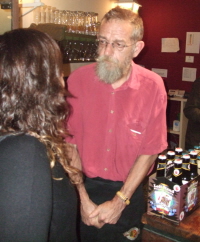 Steve Huxley advises a customer Young owner-managers Rubén Rios and Guillem Laporta are two friends with a passion for beer, but the spiritual guru, and now full-time employee, of the enterprise is Steve Huxley, a Liverpudlian long resident in Barcelona and author of the first comprehensive Spanish guide to brewing and beer appreciation, La cerveza…poesía líquida (Beer…liquid poetry). In 1993 Steve founded a pioneering brewpub which enjoyed great success until it was shut down two years later by the excise men. “No one had started a brewery here for so long,” says Steve, “we didn’t even know there was paperwork.”
 La Cerveteca celebrates World Beer Cup winners Steve subsequently founded beer enthusiasts’ organisation Humulus Lupulus, which has acted as an inspiration to a handful of recently founded local micros. You’ll find some of their products on Cerveteca’s shelves, though few can yet match the imports for quality. One exception is tiny farmhouse brewery Agullons, whose US-inspired craft ales have benefitted from Steve’s advice and have even appeared at festivals in Belgium and the UK. Catalunya is renowned for its fine architecture, art, food and drink – Catalans deserve a beer renaissance too, and Cerveteca could just be its epicentre.
Fact file
Address:Gignàs 25, 08002 Barcelona
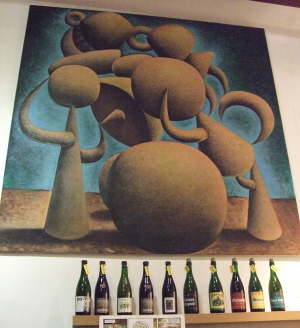 The art of beer Phone: +34 93 315 0407
Web: www.lacerveteca.com
Hours: Mon-Tues 1600-2200, Wed-Sun 1200-2200
Drink in? Yes
Mail order: No.
Manager’s favourites: Guillem: Senne Stouteric; Rubén: Agullons Pura Pale; Steve: Anderson Valley Boont Amber, “1960s Draught Bass from the Union system”.
Beer picks
- Agullons Bruno 4.5% Mediona, Catalunya, Spain. Substantial but refreshing unfiltered pale ale with a dash of sappy crystal malt and a perfumed grapefruit bite from a new micro in wine country.
- Cantillon Lou Pepe Gueuze 5% Anderlecht, Bruxelles, Belgium. Made only with mature lambics refermented with sugar primings, a mellower but still biting and complex gueuze from an uncompromising artisanal brewery.
- Coopers Vintage Ale 7.5% Regency Park, South Australia. A stronger matured beer from the celebrated Sparkling Ale brewer, rich with apple and soft fruit, whiskyish oak and late roast almonds.
- Hoepfner Kräusen 5.1% Karlsruhe, Baden-Württemberg, Germany. This superb and subtle unfiltered lager with vanilla honey, citrus, cleansing berry notes and a refined finish was a 2008 World Beer Cup category winner.
- Left Hand Milk Stout 5.2% Longmont, Colorado, USA. Malty liquorice coffee cake, cola, strawberry fruit, gentle hops and milk gum stickiness distinguish this version of a rare style from an innovative brewer.
|
Cask  This pioneering new book explains what makes cask beer so special, and explores its past, present and future. Order now from CAMRA Books. Read more here. This pioneering new book explains what makes cask beer so special, and explores its past, present and future. Order now from CAMRA Books. Read more here.
London’s Best Beer  The fully updated 3rd edition of my essential award-winning guide to London’s vibrant beer scene is available now from CAMRA Books. Read more here. The fully updated 3rd edition of my essential award-winning guide to London’s vibrant beer scene is available now from CAMRA Books. Read more here.
|



















